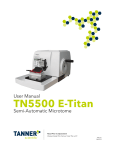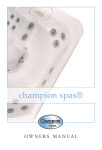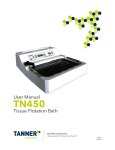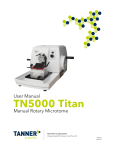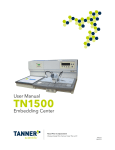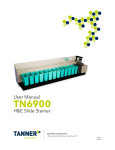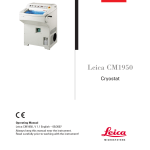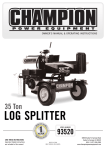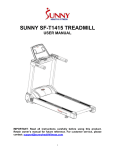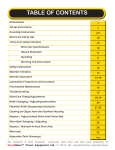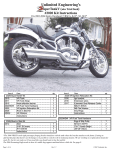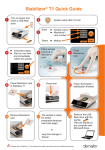Download view manual - Tanner Scientific
Transcript
User Manual TN2085 Cryostat Semi-Automatic Cryostat Read Prior to Operation! Always keep this manual near the unit! WP47113 06.02.15 User Manual TN2085-Cryostat 888.708.5233 | [email protected] | www.TannerScientific.com Contents 1 | General Summary..................................................Page 2 2 | Safety Precautions..............................................................3 3 | Technical Parameters........................................................4 4 | Installation..............................................................................5 5 | Equipment Overview........................................................6 6 | Operation.............................................................................12 6.1 | Main Control Panel........................................................................Page 12 6.2 | Turning the Instrument On.......................................................................13 6.3 | Turning the Instrument On.......................................................................13 6.4 | Peltier Element..............................................................................................13 6.5 | Temperature Setting...................................................................................14 6.6 | Time Setting...................................................................................................14 6.7 | Programming the Working Time for Each Day.................................15 6.8 | Programming the Defrost Cycle.............................................................15 6.9 | UV Sterilization Lamp.................................................................................16 6.10 | Stand By.........................................................................................................16 6.11 | Illumination...................................................................................................16 6.12 | Use of Liquid Waste Container.............................................................16 6.13 | Specimen Forward & Backward Feed................................................16 6.14 | Section/Trim Thickness Selection.........................................................17 6.15 | Right Side Control Panel..........................................................................17 7 | Cleaning & Maintenance.............................................18 8 | Warranty & Service.........................................................19 9 | Troubleshooting...............................................................20 Tanner Scientific® TN2085 - Semi-Automatic Cryostat 1 1 | General Summary Model TN-2085 Semi-Automatic Cryostat Microtome is a medical device used for rapid freezing of pathological sections of human and animal tissue. It can be widely used for pathological diagnosis, analysis and research in hospitals, medical colleges, and by legal medical experts. It utilizes advanced horizontal feeding and the specimen chamber area is much larger than competing models. A B E F C G Instrument Consists of 4 Major Parts: H • The computer control panel is on the upper part of the instrument. This area displays the temperature and the general working conditions of the instrument. • The low temperature chamber is used to rapidly freeze the tissue and to conduct cutting. • The compressor, cooling condenser and evaporator are located in the lower part of the instrument. • The microtome assembly is located inside the chamber. D A) MAIN CONTROL PANEL B) LEFT SIDE CONTROL PANEL C) GLASS WINDOW D) LIQUID WASTE BOTTLE E) POWER SWITCH F) RIGHT SIDE CONTROL PANEL I G) MOVING HANDLE H) HAND WHEEL I) STABILIZING LEGS Main Control Panel FREEZING SHELF AREA FREEZING CHAMBER AREA 2 Tanner Scientific® TN2085 - Semi-Automatic Cryostat TIME SETTING AREA SPECIAL FUNCTION AREA 2 | Safety Precautions This user manual includes important instructions and data related to the operating safety and maintenance of the instrument. The user manual is an important part of the product. It must be read carefully before using the instrument for the first time and must always be kept with the instrument. This cryostat may only be operated by qualified personnel. In case of malfunction, contact a qualified service technician. Do NOT try and solve the problem yourself. Power Supply • A professional electrical engineer should inspect the electrical circuit before installation. • The instrument uses a single phase AC power supply; the voltage is 110-115±11V. If the power does NOT meet this requirement, then a 2000-3000VA AC voltage regulator shall be connected for usage. • A dedicated 20AMP circuit is required. • Confirm the power supply is grounded (triple socket), then connect the instrument with the main power socket. Turn on the power switch in the back of the instrument to start the machine. Temperature • The instrument’s working ambient temperature is +5°C ~ +28°C. High temperature or humidity will influence freezing effect and shorten compressor life. Operating • The blade is sharp, exercise extreme caution when handling it. • NEVER TRY TO CATCH A FALLING BLADE! • Before changing specimens, always lock the hand wheel and cover the blade edge with the blade guard. Make sure the hand wheel is in the locked position when the instrument is NOT in use. • Avoid contact with cold parts of the instrument. Tanner Scientific® TN2085 - Semi-Automatic Cryostat 3 3 | Technical Parameters Section Thickness Range: 1-60µm Adjustable, Increment: 1µm, Increment: ±20°C Trimming Thickness Range: 10-300µm Adjustable, Increment: 10µm, Increment: ±20°C Specimen Retraction: 20µm Horizontal Stroke: 1” Vertical Stroke: 1.75” Specimen Orientation: 8°C (X, Y, X Three Directions) Voltage: 110V±10%, 15AMP Frequency: 50Hz Power: 850VA Largest Start-up Current: (5 sec) 45A Chamber Temperature: -10°C ~ -35°C Adjustable Freezing Shelf Temperature: ≤ -50°C Number of Freezing Stations: 18 Peltier Number: 2 Refrigerant: R404a, 300g±10g Compressor Oil: 0.6L EMKARATE RL-22S, ICI Dimensions Width (w/o Hand Wheel): 26.7” Width (w/Hand Wheel): 32.5” Depth: 27.5” Height:45.3” Weight: 278lbs 4 Tanner Scientific® TN2085 - Semi-Automatic Cryostat 4 | Installation Transportation/Unpacking • Unit must be shipped in the upright position. If the unit was shipped or stored lying down, it MUST stand upright for 36 hours before use for all lubricating oils to enter the compressor. • The instrument should only be used after 4 hours of standing still to ensure proper lubricant distribution. • Please inspect the package for damage. If it is damaged, do NOT open. Immediately contact Tanner Scientific®, and the transportation carrier. Site Requirements • Do NOT operate in rooms with or near explosive chemicals. • Place instrument at least 30cm from other instruments. • Areas on both sides of the instrument should be clear to allow proper air flow to the cooling unit. • Do NOT place the instrument in rooms above 75°F or a humid environment. The environment’s relative humidity should be no more than 80%. Failure to follow this procedure could cause frosting and icing in the chamber. • Do NOT place instrument directly in sunshine or near air condition vents. Placement • The instrument is a movable floor model with 4 caster wheels. It also features two stabilizing legs in the front that are adjustable to level the cryostat. • The instrument must be transported in an upright position. When tilted, the compressor oil is displaced and can cause problems. Hand Wheel Assembly • Insert the pin of the hand wheel shaft into the hole of the hand wheel. • Mount the spring washer on the screw (M10x15). • Tighten the screw with a #6 Allen key. Freezing Chamber Assembly • Place the waste tray in the freezing chamber. • Install blade holder on the microtome base and lock it in. • Place all tools needed for specimen preparation in the chamber. • Close glass window. Connect Power Check your power socket to ensure it is well grounded and that the power supply is stable, constant and accurate. Compressor requires a start-up current between 45 and 50A. Tanner Scientific® TN2085 - Semi-Automatic Cryostat 5 5 | Equipment Overview FREEZING SHELF HEAT EXTRACTOR STATION FREEZING DISC PELTIER STATION SPECIMEN Freezing Shelf The freezing shelf has 20 stations and is located at the left of the freezing chamber. The freezing shelf can drop as low as -40°. The two project stations in the front of the freezing shelf are Peltier stations and they can drop to -60°. The procedure for preparing specimen is as follows: • Cut specimen into the proper size. • Place specimen onto freezing disc between layers of tissue freezing medium. • Put freezing disc into a station on the freezing shelf. • Use heat extractor to flatten the specimen surface. • The specimen will freeze quickly. • Move the heat extractor away after its frozen. • Insert the freezing disc with the specimen into the hole of the clamp on the microtome, and then tighten the locking handle. • Adjust the angle of the knife holder and blade. • Rotate the hand wheel accordingly to cut the specimen into sections. 6 Tanner Scientific® TN2085 - Semi-Automatic Cryostat Microtome Component NOTE: Before inserting freezing disc, please lock hand wheel securely. 2 1 3 4 6 5 1 – Freezing Disc Locking Handle 4 – Extractor Hole 2 – Orientation Adjustment Handle 5 – Knife Holder Locking Block 3 – Orientation Lever 6 – Specimen Hole (Inserted Freezing Disc) Insert Freezing Disc • Release the freezing disc locking handle. • Insert the shaft of the freezing disc into the location hole of the specimen clamp. Make sure the shaft of the freezing disc is fully inserted. The entire rear surface of the prism should make contact with the specimen clamp easily; there should be no gap between them. • Lock the freezing disc locking handle. • Observe the cutting angle and, if necessary, adjust the orientation. • To adjust orientation: - Loosen orientation adjustable handle. - Adjust orientation lever to choose best cutting angle. - Relock orientation. Tanner Scientific® TN2085 - Semi-Automatic Cryostat 7 Blade Holder Position Adjustment CLAMPING LEVER FOR LOCKING BLADE CLAMPING LEVER FOR MOVING BLADE HOLDER FRONT AND BACK CLAMPING LEVER TO MOVE BLADE HOLDER LEFT TO RIGHT ANTI-ROLL PLATE ADJUSTING KNOB CLAMPING LEVER TO ADJUST CUTTING ANGLE OF BLADE ANTI-ROLL PLATE SLIDE CLAMPING LEVER FOR MOVING BLADE HOLDER 8 Tanner Scientific® TN2085 - Semi-Automatic Cryostat Release (counter clockwise) blade holder lock handle on the left (refer to diagrams of blade holder on pg. 8). Manually move the holder back and lock it in the desired position. When the holder moves to the terminal point, the entire blade holder can be taken out and put back by reversing this procedure. Release (counter clockwise) blade holder lock handle on the right, manually move the holder left and right and lock it at the desired position. NOTE: Remember to lock the blade holder to right position when doing forward or backward specimen adjustment. Changing the Blade Release the clamping lever on the upper right to open the blade clearance and then insert the blade from left to right; then lock the clamp lever (refer to diagrams of blade holder shown on pg. 8). NOTE: Blade is sharp, be careful when replacing. Adjusting the Angle of the Blade Loosen the lowest adjustment handle on the right side of the blade holder. Refer to the reference scale to turn rotator in order to choose the best cutting angle of the blade. Retighten the adjustable handle. Adjusting the Anti-Roll Plate The anti-roll plate is made of plexiglass. KNOB FOR CLAMPING ANTI-ROLLING PLATE ANTI-ROLLING PLATE HEIGHT KNOB USE A HEXAGONAL WRENCH ON BLADE AND SLIDE TO MAKE PARALLEL Tanner Scientific® TN2085 - Semi-Automatic Cryostat 9 Adjusting the Anti-Roll Plate includes the following steps: 1- Make the edge of the anti-roll plate parallel to the edge of the blade. • Insert blade and lock the clamping lever. • Lock two knobs. • Use hexagonal wrench to make blade and anti-rolling plate parallel. • Fasten hexagonal screw. • Turn height turning knob to adjust height of anti-rolling plate. 2- Adjust the anti-rolling plate angle with the blade. TISSUE ANTI-ROLL PLATE 30 ° ADJUSTABLE ANGLE 10 ° ANGLE OF CUTTING BLADE EDGE NOTE: The angle should be no more than 10º. 3- Make sure the edge of the plate and the edge of the blade are flush. 1- The upper part of the anti-roll plate should not contact the tissue specimen. EDGE OF PLATE AND BLADE MEETING FLUSH 2- When the quality of the tissue section is not good, check the edge of the blade and check any segment of tissue on the plate. 3- Avoid touching the front of the plate because high temperature will adhere the tissue section to the plate. 10 Tanner Scientific® TN2085 - Semi-Automatic Cryostat ANTI-ROLL PLATE HEIGHT TURNING KNOB Section Reference 1- When using the cryostat’s microtome, controlling the blade speed and correctly adjusting the anti-roll plate are important factors in cutting high quality sections. The proper speed of the blade can only be acquired by practice and experience, along with skillful control of the hand wheel. The proper adjustment of the anti-roll plate requires even more practice. Sometimes they interfere with each other, and require adjustment. 2- When freezing tissue, water within the tissue will condense into ice, and the tissue will become hard. The hardness changes with the temperature. The lower the temperature, the harder the tissue becomes. Different tissue reacts in various ways under different temperatures. Achieving high quality sections can only be obtained through practice. Cutting temperatures of specimen tissue without fat and formalin should be between -13°C ~ -23°C. 3- For high quality sectioning, pay attention to the following: • Proper temperature in the chamber. • Correct operation and hand wheel speed. • Fine adjustment of the anti-roll plate. • Sharp blade edge, correct blade angle. Hand Wheel Lock ROTARY LEVER LOCKING SPANNER Tanner Scientific® TN2085 - Semi-Automatic Cryostat 11 6 | Operation General Overview MAIN CONTROL PANEL LEFT SIDE CONTROL PANEL POWER SWITCH RIGHT SIDE CONTROL PANEL GLASS WINDOW MOVING HANDLE HAND WHEEL LIQUID WASTE BOTTLE STABILIZING LEGS 6.1 | Main Control Panel • The main control panel is separated into 4 parts. From left to right, they are: the Freezing Shelf Area, the Freezing Chamber Area, the Time Setting Area and the Special Function Area. FREEZING SHELF AREA FREEZING CHAMBER AREA 12 Tanner Scientific® TN2085 - Semi-Automatic Cryostat TIME SETTING AREA SPECIAL FUNCTION AREA 6.2 | Turning the Instrument On Turn on the power switch on the right side of the instrument. The cryostat will power up and begin cooling. On initial start up, the unit will automatically go into standby mode, only cooling to the default standby temperature of -9°C to -10°C. Turn off the standby mode by pressing the key. The unit will now cool to user’s set temperature. Allow unit to completely cool for a minimum of 12 hours from ambient temperature. This will insure the entire chamber and microtome is at set temperature. 6.3 | Shutting Down the Instrument It is advisable the unit be properly shut down to avoid excess stress on the refrigeration system. (The compressor should not be running when you turn off the power switch). Press the button to increase temperature by 5°C and wait until the compressor shuts off. Turn off the power switch on the right side of the instrument. RIGHT SIDE CONTROL PANEL LEFT SIDE CONTROL PANEL Important! Before restarting the unit, make sure the entire chamber and microtome are completely dry. Otherwise, ice will form and may cause damage to the microtome assembly. Advancement/retraction may not be obtained due to freezing of the step motor. 6.4 | Peltier Element Under a normal state, the Peltier element is off. The LED shows the freezing shelf temperature. When you press the Peltier button, the indicator light comes on and the Peltier element begins to work to cool down the freezing stations. The LED displays (L15), which means the Peltier element will work in 15 minutes. The countdown of the remaining cooling time is now permanently displayed. The Peltier element turns off automatically after 10 minutes. Once the remaining cooling time displayed shows 4 minutes, the number four is followed by a point (4.). At this stage the Peltier element may be deactivated by pressing the Peltier button again. Once deactivated, the display indication returns to (PE). Pressing the button during the Peltier element working process will stop the Peltier freezing immediately. Tanner Scientific® TN2085 - Semi-Automatic Cryostat 13 6.5 | Temperature Setting The compressor will start to work after the power switch is turned on. This allows the freezing chamber to cool down. The freezing chamber temperature is displayed and adjusted in the temperature set area. The LED displays the temperature of the sensor in the freezing chamber. Freezing Chamber Temperature Display & Settings: System Default is -22°C. When the TN-2085 Cryostat is powered up and standby mode is off, press to increase the temperature and to decrease the temperature. The unit’s LED will flash to display the set value. When set to the desired temperature, wait about 15 seconds and the instrument will return to its normal state. 6.6 | Time Setting DISPL AY PANEL BUT TONS: SUN: Sunday AM: Morning TUE: Tuesday W-DAY: Working Day MON: Monday WED: Wednesday THU: Thursday FRI: Friday SAT: Saturday After turning on the system, verify that the default time is correct or reset it. Press the KEY button to access the setting mode. Press the (D), (H) or (M) button to adjust the day, hour and minute. Press the KEY button again to resume normal operation. NOTE: If the setting time is over 10 seconds between two operations, the system will automatically return to normal state. 14 Tanner Scientific® TN2085 - Semi-Automatic Cryostat PM: Afternoon D: Day H: Hour M: Minute : Defrost 6.7 | Programming the Working Time for Each Day While in the idle state press the and (indicating setting mode is unlocked), button to enter programming mode. The LED will display as (Image A), indicating a working-time setting mode. Press (D), (H) or (M) to select the day and time the instrument should start running. Press the button again to enter “switch off” mode to set up the date and time. The instrument should stop running and stay in the idle state (Image B). IMAGE A IMAGE B NOTE: User can press (W-DAY) to set up a group of days at once. By pressing the (W-DAY) key, all the days of the week will be set to the same ON and OFF times. 6.8 | Programming the Defrost Cycle Press key button, then press in the time control area. When the frost indicator light comes on, you can adjust the defrost settings. The indicator lights up for ALL days of the week. This is because the defrost cycle ILLUMINATION runs at the same time each day. You can adjust the time by pressing the hour button (H) and minute button (M). Select the time that you would like the defrost cycle to run. STAND BY Fast Defrost Button: The fast defrost button is located in the special function area. Under the normal freezing state, it is NOT lit. Press to activate the defrost function. The indicator light will go on as the system goes into fast defrost mode. The unit should then defrost within a 6 minute time FAST DEFROST period. To cancel fast defrost, press the button again. The indicator light will go out simultaneously. If system automatically enters fast defrost mode, the UV STERILIZE button lights up, too. Press it again to stop fast defrost and the indicator light will turn off. Tanner Scientific® TN2085 - Semi-Automatic Cryostat 15 6.9 | UV Sterilization Lamp Press the UV button to make the lamp active; press once more to stop it. Indicator light is on or off correspondingly. UV STERILIZE UV RADIATION IS HARMFUL FOR THE HUMAN BODY. When doing UV sterilization, do not forget to close glass window and keep hands away from chamber. Before doing UV sterilization, please remove all specimens and clean chamber first. 6.10 | Stand by Press once to enter into standby mode. Press again to return to normal working mode. Indicator light is on or off correspondingly. In standby mode, the freezing chamber temperature is maintained between -4 and -8, to conserve electricity. STAND BY 6.11 | Illumination Press button to turn lamp on. Press again to turn off. 6.12 | Use of Liquid Waste Container Use waste barrel to collect defrosted liquid, tissue thawing solution, flushing liquid and waste objects. In order to prevent both human and environmental hazard from the waste, put 200mL 10% formalin or other sterile solution into the barrel in advance. The disposal of the waste shall follow all the related regulations of the hospital. NOTE: Please use the corrected and effective method to treat the waste. 6.13 | Specimen Forward and Backward Feed Specimen forward and backward feed is for fast movement of the specimen position. If you press the button, the specimen goes to home position in normal speed. If you press the normal speed. If you press the position in fast speed. Pressing the button, the specimen goes forward in button, the specimen moves to home button moves the specimen to the opposite direction in fast speed. Press the button again to cancel moving command. 16 Tanner Scientific® TN2085 - Semi-Automatic Cryostat ILLUMINATION 6.14 | Section/Trim Thickness Selection Above the LED displays the thickness value of section/trim. If (SECT) lights up, LED displays section thickness, otherwise, it is trim thickness. Press (S/T) button to change from selection to trim one time or conversely. SECTION/TRIM SECTION DISPLAY Section Thickness Range: 1-60µm (default value is 6µm) 1 ~ 20µm, in 1µm steps 20 ~ 60µm, in 5µm steps Trim Thickness Range: 10~300µm (default value is 30µm) 10 ~ 60µm, in 5µm steps 60 ~ 100µm, in 10µm steps 100 ~ 300µm, in 50µm steps Thickness Selection Under current working mode, press (+) or (—) to adjust section or trim thickness. Section Turn the hand wheel one rotation. The system will cut a piece of section one time and the thickness will be displayed. NOTE: When adjusting specimen movements, the hand wheel must be locked in the right position. 6.15 | Right Side Control Panel RIGHT SIDE CONTROL PANEL The right side control panel consists of counter and vacuum extractor control sections. Counter The figure above the LED displays the number of wheel rotations and thickness. When (Σn) lights up, the number of rotations is shown in the LED screen. When (Σµm) lights up, the total thickness is shown. Press (M) button to change from total pieces to total thickness or conversely; press (C) to clear all the numbers. VACUUM EXTRACTOR Vacuum Extractor Vacuum extractor is designed for cleaning tissue scrap. Press button of the right control panel to enable the extractor motor. Press once for 3 seconds of the vacuum and press twice for continuous run. The indicator light on the upper corner of the symbol comes on. Move the speed controller on the left side to adjust the motor speed so you get suitable air volume. Press again to disable it and the indicator light will turn off simultaneously. Tanner Scientific® TN2085 - Semi-Automatic Cryostat 17 7 | Cleaning & Maintenance These machines are precision instruments. Pay attention to cleanliness, maintenance and repair work. Do NOT use organic solvents or any aggressive substances to clean and sterilize the chamber! Only use the cleaning agents specified in this manual such as alcohol or common disinfectants based on alcohol. It may be necessary to conduct a manual defrost before cleaning if the chamber is full of frost. If necessary, the external painted surface may be cleaned with light-duty commercial household cleaner. Use a wet cloth and rub until dry. Do NOT apply xylene or cleaning solutions that contain alcohol (Ex: glass cleaner). Daily Cleaning of Freezing Chamber Conduct the following steps before cleaning each time: • Remove all the specimens from freezing chamber. • Lock the hand wheel. • Remove the blade from the blade holder and put it back in the blade box. • Activate the vacuum to clean away scraps. • Empty the waste tray. • Use alcohol or common disinfectants to clean up baffle and brush shelf. • Collect the waste cleaning liquid from the barrel and dispose of it. Spray Disinfection The cryostat must be disinfected after each daily use. The steps to ensure the machine is adequately cleaned are as follows: • Cool down freezing chamber to -20°. • Spray with disinfectant. • Wait 15 minutes. • Wipe chamber off with tissue paper or dry cloth. • Reprogram temperature according to slicing requirement after disinfection. Blade Holder Cleaning If the blade holder sticks and/or contains impurities, then dismount and clean as follows: • Turn adjustable handles in the lateral of the rotator and draw out sideways. • Push the knife clamp back which has knife clip and shift it out from rotator. • Turn rod handle in the lateral of the knife cap and draw out sideways. • Clean all the assemblies of the blade holder. • Dry off all assemblies and apply a drop of low temperature lubrication oil. • Reassemble blade holder and put into the freezing chamber. 18 Tanner Scientific® TN2085 - Semi-Automatic Cryostat 8 | Warranty & Service Tanner Scientific® warrantees this product for a period of one year from the date of purchase, provided that the customer complies with the rules of this manual. Extended warranties are available. Contact Tanner Scientific® at 888.708.5233 for more information. Tanner Scientific® will not be responsible for the damage and other problems caused by abuse and misuse of the instrument. Service Information If you require any service or parts during the warranty period, please contact Tanner Scientific® at 888.708.5233 or the sales agent who sold you the unit. Prior to calling, please have the instrument model and serial number ready. Amendment Tanner Scientific® reserves the right to change the technical parameters of any model for improving the function of our instruments. Quality Guarantee • Tanner Scientific® will ensure that every instrument sold has been strictly examined to ensure it meets our stringent quality and technical standards. • Service terms are only provided for those who regularly use the instrument and operate the instrument according to its instructions. Disposal of Unwanted Instruments Discarding the instrument and its parts should be done according to current laws and regulations. Tanner Scientific® TN2085 - Semi-Automatic Cryostat 19 9 | Troubleshooting SEMI-AUTOMATIC CRYOSTAT PROBLEMS C AUSES ELIMINATION + Section smears. + Specimen not cold enough. + Blade and/or anti-roll plate not yet cold enough. + Select lower temperature. + Wait until the blade and/or anti-roll plate have reached chamber temperature. + Section splinters. + Specimen too cold. + Select a higher temperature. + Sections not properly flattened. + Static electricity. + Specimen not cold enough. + Large area specimen. + Anti-roll plate is poorly positioned or aligned. + Incorrect clearance angle. + Blade is not sharp enough or damaged. + Remove cause. + Select lower temperature. + Trim the specimen parallel to increase the specimen thickness. + Reposition the anti-roll plate; align correctly. + Set correct angle. + Use different part of cutting edge. + Sections not properly flattened despite correct temperature and correctly aligned anti-roll plate. + Blade and/or anti-roll plate is dirty. + Edge of anti-roll plate is damaged. + Blunt blade. + Clean with dry cloth or brush. + Replace plate. + Use different part of the cutting edge or replace. + Sections curl on the anti-roll plate. + Anti-roll plate does not protrude far enough beyond the cutting edge. + Readjust correctly. + Ridged sections. + Damaged blade. + Edge of anti-roll plate is damaged. + Use different part of the cutting edge or replace blade. + Replace plate. + Chatter during sectioning. + Specimen insufficiently frozen onto the specimen disc. + Specimen disc not clamped tightly. + Blade not clamped tightly enough. + Specimen has been sectioned too thickly and detached from the disc. + Blunt blade. + Blade profile unsuitable for the specimen to be cut. + Incorrect clearance level. + Refreeze specimen onto the disc. + Check disc clamping. + Check blade clamping. + Use different part of the cutting edge or replace blade. + Use blade with different profile. + Set correct angle. + Sections tear. + Temperature too low for tissue cut. + Blunt part, dust, dirt, frost or rust on the blade. + Leading edge of the anti-roll plate is damaged. + Hard particles in the tissue. + Increase temperature and wait. + Remove cause from blade. + Replace plate. + Flattened sections curl up when anti-roll plate is picked up. + Static electricity or air currents. + Anti-roll plate too warm. + Remove static electricity. + Cool down the anti-roll plate. + No or insufficient refrigeration. + Compressor defective. + Leak in the cooling system. + Inappropriate site conditions. + Ventilation slits of the liquefier dirty. + Call technical support. + Clean ventilations slits. 20 Tanner Scientific® TN2085 - Semi-Automatic Cryostat PROBLEMS C AUSES ELIMINATION + Thin/thick sections. + Temperature incorrect for tissue cut. + Blade profile inappropriate for specimen cut. + Ice buildup in the blade back. + Hand wheel speed not uniform. + Blade not clamped tightly enough. + Specimen holder not clamped tightly. + Cryocompund applied to cold specimen disc; specimen detached from the disc after freezing. + Blunt cutting edge. + Incorrect clearance angle. + Microtome not properly dried before reinstallation. + Dried specimen. + Increase temperature and wait. + Remove cause from blade. + Replace plate. + Scraping noise during sectioning and specimen return movement. + Anti-roll plate protrudes too far beyond the cutting edge and is scraping against the specimen. + Readjust correctly. + Scraping noise at the microtome. + Friction between the slot cover and the microtome housing. + Apply cryostat oil to the slot cover and distribute by turning the hand wheel or with a cloth. + Frost on chamber walls and microtome. + Cryostat is exposed to air flows (open windows and doors). + Sliding window was open and exposed to air flow too long. + Frost built up by breathing into the cryochamber. + Change the position/area in which the cryostat is installed. + Ice formations on the bottom of the cryochamber. + Condensation water drain blocked. + Open the tap of the drain tube, turn off the instrument and allow it to thaw and dry. + Condensation on anti-roll plate and blade during cleaning. + Brush, forceps and/or cloth too warm. + Store all tools on shelf in chamber. + Anti-roll plate damaged after adjustment. + Plate too high above the cutting edge; the adjustment was carried out in the direction of the cutting edge. + Raise plate when aligning. + Be more careful next time. + Tissue sticks or crumbles on the anti-roll plate. + Anti-roll plate too warm or incorrectly positioned. + Static electricity. + Fat on corner/edge of anti-roll plate. + Rusty blade. + Cool down anti-roll plate or reposition plate. + Remove static electricity source. + Remove fat with alcohol. + Remove rust or replace blade. + Inconsistent or insufficient specimen feed. + Microtome was not entirely dry when switching on a refrigeration; subsequently ice built up in the micrometer feed system. + Defective microtome. + Remove the microtome and dry it thoroughly before reinstallation. + Call technical support. + Specimen disc cannot be removed. + Moisture on the underside caused the disc to freeze to the freezing shelf or specimen head. + Apply concentrated alcohol to the contact point or heat the specimen head. + Cryostat not operational. + Main plug not properly connected. + Defective fuses. + Temperature control switch activated. + Check that the main plug is properly connected. + Replace the fuses. + Reset temperature control switch. Tanner Scientific® TN2085 - Semi-Automatic Cryostat 21 Information The information, notes, and figures that appear in this user manual represent the present state of knowledge as we comprehend it. Due to continuous improvements in technology and manufacturing technique, specific and manufacturing procedures may change. For inaccurate statements, drawings, and technical illustrations in this user manual we exclude liability as far as permissible. No liability is accepted for any monetary loss or consequential damage caused by or related to compliance with statements or other information in this user manual. Tanner Scientific® will update the manual as needed according to the latest technological developments. This document is protected under copyright laws. Any reproduction of illustrations or text requires prompt documented consent by Tanner Scientific®. Statements, drawings, illustrations and other information regarding contents or technical details of the present user manual are not to be considered as warranted characteristics of our products. These are determined only by the contract provisions agreed between us and our customers. Refer to the name plate on the back of the unit for the serial number and manufacturing date of this instrument. Distributed by Tanner Scientific 1073 Tallevast Rd Sarasota, Florida 34243 888.708.5233 [email protected] www.TannerScientific.com 1073 Tallevast Rd Sarasota, Florida 34243 888.708.5233 [email protected] www.TannerScientific.com


























